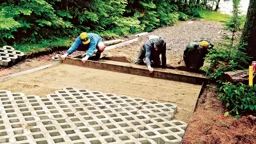Fear. Desire. The survival of the fittest and the lucky. Living in the wild takes moxie and a suitable environment. From the perspective of a trout or a bass, this means great water chemistry, abundant food, a place to rest, and a bed in which to spawn. The National Oceanic and Atmospheric Administration’s Fisheries Office of Habitat Conservation calls this “Essential Fish Habitat” (EFH). Maybe you just call it your lake?
Managing fish populations and habitat is often left to federal and state natural resource agencies. They might team up with anglers to install lunker structures, where trout can hide from predators and can grow large. In New Hampshire, the state’s Fish Habitat Program has tackled shoreline restoration, fluvial geomorphology (a science devoted to understanding how the natural setting and human land use in a watershed determine the shape of the river channel), and land use. It is not just the government’s job to manage fish habitat, however. The onus is on all of us.
“The best thing that you can do for fish is to be a good steward of natural resources,” says Ryan Roberts, Communications Coordinator for the National Fish Habitat Partnership. Especially for those who own shoreline, consider pursuing the following fish-friendly tips.
1. Leave fish a place to hide to help them flourish.
2. Rocky bottoms can become fish spawning grounds.
3. Let natural flora grow along the shore to slow runoff. (Access the water via a small pathway, cut at an angle.)
4. If you want to improve your view of the lake or river, practice strategic tree pruning, not culling. (This is critical on sloped yards for stabilizing the soil to prevent erosion.)
5. Trees along the shore provide shade for fish on scorcher days, stabilize the shoreline, and filter runoff water before it gets to the lake.
6. Apply fertilizers and pesticides sparingly and away from the water. Or consider selling your lawn mower and letting nature reclaim its own. (Fertilization can lead to fish kills and algal blooms.)
7. With stormwater runoff in mind, plan for pervious driveways and pathways. And use gutters and rain barrels for buildings. (The slower runoff flows, the less sediment, oil and other dreck it carries to a lake, pond or river.)
8. Clean your boat, motor and gear immediately after taking them out of a body of water so you don’t spread invasive species like Eurasian watermilfoil to other water bodies.
9. Maintain or replace your 2-stroke boat motor to prevent leakage. (About 30% of all fuel and oil used in these engines ends up in the water.)
10. Use a floating dock to manage fluctuating water levels. (Avoid dredging the lake bed. Besides damaging fish habitat, dredged areas often quickly refill with sediment.)
11. Wait for a fish-friendly season before taking on a project around your dock, pier or boat lift. Usually this is late summer or fall when the water level is lowest and after warmwater fish species (perch, bass, sunfish, pike, walleye) have finished spawning. Note that coldwater fish (trout, whitefish, cisco) generally spawn in the spring or fall. If your project requires you to remove rocks or woody debris, save them and return them to the same area or a nearby area of equal depth.
NOTE: To view the illustration with each of these tips, click on the PDF link below.
Managing fish populations and habitat is often left to federal and state natural resource agencies. They might team up with anglers to install lunker structures, where trout can hide from predators and can grow large. In New Hampshire, the state’s Fish Habitat Program has tackled shoreline restoration, fluvial geomorphology (a science devoted to understanding how the natural setting and human land use in a watershed determine the shape of the river channel), and land use. It is not just the government’s job to manage fish habitat, however. The onus is on all of us.
“The best thing that you can do for fish is to be a good steward of natural resources,” says Ryan Roberts, Communications Coordinator for the National Fish Habitat Partnership. Especially for those who own shoreline, consider pursuing the following fish-friendly tips.
1. Leave fish a place to hide to help them flourish.
2. Rocky bottoms can become fish spawning grounds.
3. Let natural flora grow along the shore to slow runoff. (Access the water via a small pathway, cut at an angle.)
4. If you want to improve your view of the lake or river, practice strategic tree pruning, not culling. (This is critical on sloped yards for stabilizing the soil to prevent erosion.)
5. Trees along the shore provide shade for fish on scorcher days, stabilize the shoreline, and filter runoff water before it gets to the lake.
6. Apply fertilizers and pesticides sparingly and away from the water. Or consider selling your lawn mower and letting nature reclaim its own. (Fertilization can lead to fish kills and algal blooms.)
7. With stormwater runoff in mind, plan for pervious driveways and pathways. And use gutters and rain barrels for buildings. (The slower runoff flows, the less sediment, oil and other dreck it carries to a lake, pond or river.)
8. Clean your boat, motor and gear immediately after taking them out of a body of water so you don’t spread invasive species like Eurasian watermilfoil to other water bodies.
9. Maintain or replace your 2-stroke boat motor to prevent leakage. (About 30% of all fuel and oil used in these engines ends up in the water.)
10. Use a floating dock to manage fluctuating water levels. (Avoid dredging the lake bed. Besides damaging fish habitat, dredged areas often quickly refill with sediment.)
11. Wait for a fish-friendly season before taking on a project around your dock, pier or boat lift. Usually this is late summer or fall when the water level is lowest and after warmwater fish species (perch, bass, sunfish, pike, walleye) have finished spawning. Note that coldwater fish (trout, whitefish, cisco) generally spawn in the spring or fall. If your project requires you to remove rocks or woody debris, save them and return them to the same area or a nearby area of equal depth.
NOTE: To view the illustration with each of these tips, click on the PDF link below.
SCORE YOUR SHORE
Lakeshore property owners can self-assess their habitat stewardship through the Score Your Shore manual offered for FREE by the Minnesota Department of Natural Resources. The 48-page manual provides a framework for evaluating existing shoreland habitat and ideas for improving it. To download the manual, click here.
Lakeshore property owners can self-assess their habitat stewardship through the Score Your Shore manual offered for FREE by the Minnesota Department of Natural Resources. The 48-page manual provides a framework for evaluating existing shoreland habitat and ideas for improving it. To download the manual, click here.











